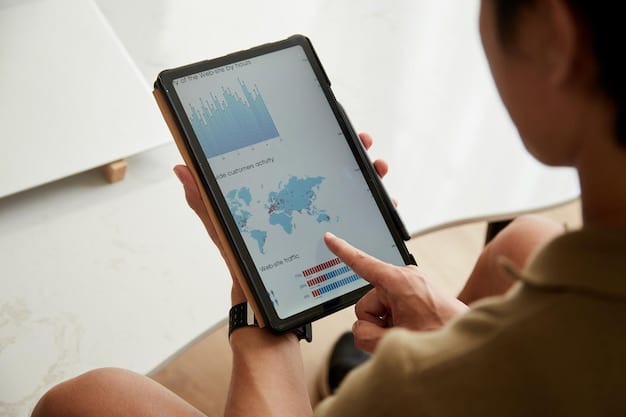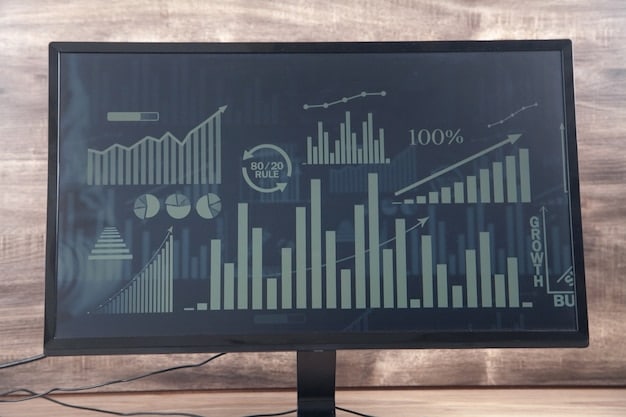Measuring Digital Marketing Success: Metrics & KPIs for 2025

Measuring the success of your digital marketing campaigns in 2025 requires focusing on key metrics and KPIs such as conversion rates, customer acquisition cost, return on ad spend, and customer lifetime value to ensure effective strategies and maximize ROI.
In the fast-evolving digital landscape, understanding how to effectively measure the success of your marketing efforts is crucial. **Measuring the success of your digital marketing campaigns: Key Metrics and KPIs for 2025** will involve a more data-driven and customer-centric approach than ever before, demanding a thorough understanding of the metrics that truly matter.
Understanding the Shifting Digital Marketing Landscape
The world of digital marketing is constantly changing, influenced by new technologies, evolving customer behaviors, and shifts in platform algorithms. To accurately measure success in 2025, you need to understand these key trends and adapt your measurement strategies accordingly.
Keeping up with these changes is essential for any marketer. The ability to adapt and evolve will determine your success and accurately gauge the effectiveness of your marketing campaigns.

Emerging Technologies and Their Impact
Technologies like artificial intelligence (AI), augmented reality (AR), and personalized advertising are becoming increasingly prevalent. Each of these technologies present new opportunities and challenges for digital campaigns.
For instance, AI can enhance targeting and automation, while AR provides immersive and engaging customer experiences.
- AI-driven analytics for predictive insights
- AR for enhanced customer engagement
- Blockchain for improved data security
These technologies demand a refined approach to campaign measurement, focusing on nuances that traditional metrics might overlook. Understanding how these technologies influence your KPIs is key.
In conclusion, staying ahead of technological advances and incorporating them into your marketing strategies is essential for success in today’s world. Marketers need to embrace change in order to grow.
Identifying Your Core Business Objectives
Before diving into specific metrics, align your digital marketing campaigns with your overarching business objectives. What goals are you trying to achieve? Whether it is increasing brand awareness, generating leads, driving sales, or improving customer retention.
Your core business objectives will determine which KPIs are the most relevant for your campaigns. When business and digital campaigns are aligned, one can measure success.
Defining Clear, Measurable Goals
Effective KPIs are those that can be directly tied to your business goals. For example, if your aim is to increase online sales, then metrics like conversion rates, average order value, and customer lifetime value become crucial.
Make sure your goals are specific, measurable, achievable, relevant, and time-bound (SMART). An example would be increasing online sales by 20% in the next quarter.
- Increase brand visibility through content marketing
- Improve customer satisfaction rates
- Drive more qualified leads through targeted ads
Aligning your digital marketing efforts with your business goals provides a clear path for assessing success and making data-driven decisions.
Therefore, aligning your digital marketing efforts with your business goals will result in a long lasting impression. When you have a clear message, you can measure success.
Key Performance Indicators (KPIs) for 2025
KPIs (Key Performance Indicators) are the quantifiable metrics you use to track and evaluate the success of your digital marketing campaigns. Selecting the right KPIs is essential for understanding how well your strategies are performing.
The right KPIs help provide you with meaningful insights, which will enable you to make data-driven decisions. Without these drivers, it is hard to measure success.

Website Traffic and Engagement Metrics
Website traffic metrics are crucial for understanding how well your digital marketing strategies are driving visitors to your site. These can include unique visitors, page views, session duration, bounce rate, and traffic sources.
Engagement metrics, such as time on page and pages per session, offer insights into how visitors are interacting with your content. This will help you optimize your content engagement.
- Monitor website traffic sources to identify high-performing channels
- Analyze bounce rate to improve landing page optimization
- Track session duration to assess content engagement
By monitoring website traffic and engagement metrics, you can gain a comprehensive understanding of your audience’s behavior. These measurements will give you a better idea of the customers journey.
In short, tracking your website’s traffic and engagement will show you how successful your digital campaigns are. Use this data for further implementation and planning.
Conversion Rate Optimization (CRO)
Conversion rate optimization helps improve the percentage of users who complete a desired action on your website, whether it’s filling out a form, making a purchase, or subscribing to a newsletter. Focusing on CRO can significantly impact your ROI.
Measuring and improving conversion rates involves testing different elements on your website, such as headlines, call-to-action buttons, and form fields. Testing is a great way to discover what drives customers to purchase from your brand.
Strategies for Enhancing Conversion Rates
To optimize your conversion rates, start by understanding your audience’s behavior and preferences. Use analytics tools to identify drop-off points and areas for improvement.
A/B testing different variations of your web pages can provide valuable insights into what resonates best with your audience. This can help you further drive sales and create relationships.
- Conduct A/B tests on landing pages and forms
- Optimize website speed for better user experience
- Craft compelling calls-to-action
By using these strategies, your website will be able to attract new customers. By optimizing your CRO, you will better improve customer experience.
In summary, CRO is all about identifying opportunities to enhance the user experience, making it easier for visitors to convert. Implementing these techniques creates higher conversion rates.
Customer Acquisition Cost (CAC)
Customer Acquisition Cost is the total cost of acquiring a new customer. This KPI includes all marketing and sales expenses, such as advertising costs, salaries, and overhead.
Understanding your CAC is crucial for assessing the profitability of your marketing campaigns and making informed budget allocations. This helps further calculate the cost of your marketing journey.
Calculating and Reducing CAC
To calculate CAC, divide your total marketing and sales expenses by the number of new customers acquired during a specific period. This will give you an average estimate.
Reducing CAC involves optimizing your marketing strategies, improving targeting, and enhancing customer retention efforts. By reducing CAC, you will further extend your campaign.
- Refine ad targeting to reach the most relevant audience
- Improve customer onboarding processes
- Implement cost-effective marketing channels
By optimizing your marketing strategies, improving targeting, and enhancing customer retention efforts, you can significantly reduce CAC and improve your ROI. Improving CAC will impact ROI.
Therefore, understanding and minimizing your Customer Acquisition Cost is a critical component of profitable and sustainable growth. When you lower the CAC, your business can flourish.
Return on Ad Spend (ROAS)
Return on Ad Spend measures the revenue generated for every dollar spent on advertising. A high ROAS indicates that your advertising campaigns are effective and profitable. ROAS is one of the critical factors that will make or break your business.
Monitoring ROAS helps you identify which campaigns are delivering the best results and where you can optimize your ad spend. It allows you to see the trends and areas of success that impact your brand.
Improving Your Advertising Efficiency
To improve ROAS, focus on creating highly targeted ads, optimizing bidding strategies, and ensuring your landing pages are optimized for conversions. The first impression is important when optimizing customers.
Regularly analyze your ad performance data to identify areas for improvement, such as ad copy, creative assets, and audience targeting. Constant review of these strategies help improve your reach.
- Implement conversion tracking to measure ad performance
- Optimize ad copy and creative for higher engagement
- Use retargeting to capture warm audience
By using these strategies, you will find it easier to grow your advertising effectiveness. These strategies also help focus on customer engagement and capture your audience.
In conclusion, consistently optimizing your advertising strategies and monitoring ROAS is essential for maximizing the impact of your ad budget. Maximizing your impact will help improve your ROAS.
| Key Metrics | Brief Description |
|---|---|
| 📈 Website Traffic | Measures the number of visitors to your site, indicating audience reach. |
| 💰 Conversion Rate | Percentage of users completing a desired action, reflecting campaign effectiveness. |
| 💸 Customer Acquisition Cost | Total cost to acquire a new customer, assessing marketing profitability. |
| 🚀 Return on Ad Spend | Revenue generated per dollar spent on ads, indicating ad campaign efficiency. |
Frequently Asked Questions (FAQ)
▼
Key KPIs include website traffic, conversion rates, customer acquisition cost (CAC), return on ad spend (ROAS), and customer lifetime value (CLTV). These metrics help assess the effectiveness and profitability of your campaigns.
▼
Improving conversion rates can be achieved through A/B testing, optimizing landing pages, crafting compelling calls-to-action, and ensuring a seamless user experience. Understanding user behavior is also essential.
▼
Strategies to reduce CAC include refining ad targeting, improving customer onboarding processes, and implementing cost-effective marketing channels. Focusing on customer retention can also lower the need for new acquisitions.
▼
ROAS reflects how well ad spend translates into revenue. You can improve ROAS by optimizing your ad creative, refining audience targeting, and consistently monitoring performance data to make informed adjustments.
▼
Aligning campaigns with business goals ensures that your marketing efforts contribute directly to the company’s overall success. Aligning campaigns helps to create a clear path for measuring success and enables data-driven decisions.
Conclusion
Measuring the success of your digital marketing campaigns in 2025 demands a strategic approach that aligns with your core business objectives. By focusing on key metrics and KPIs like website traffic, conversion rates, CAC, and ROAS, and continuously optimizing your strategies, you can ensure effective campaigns in the evolving digital world.





